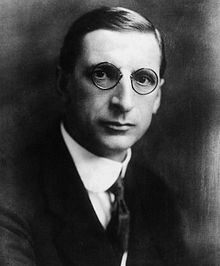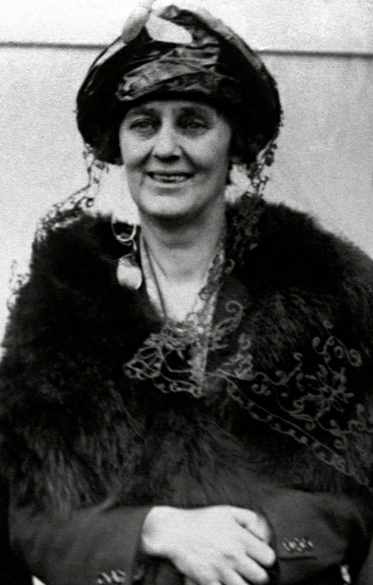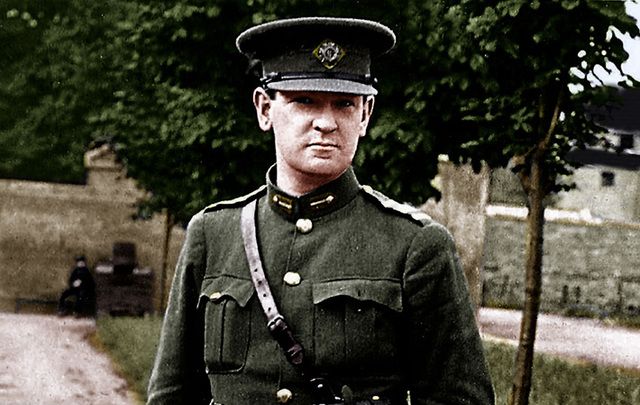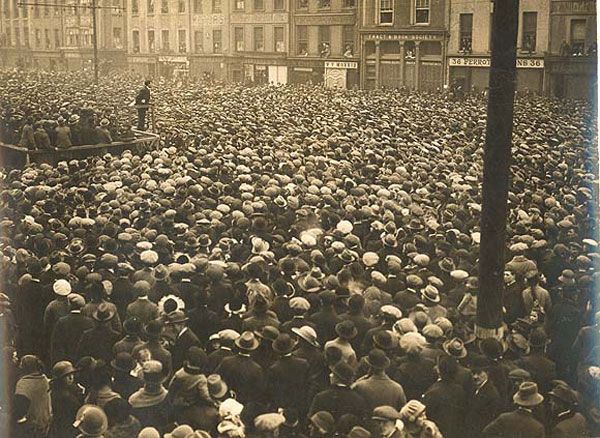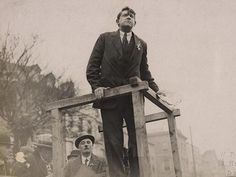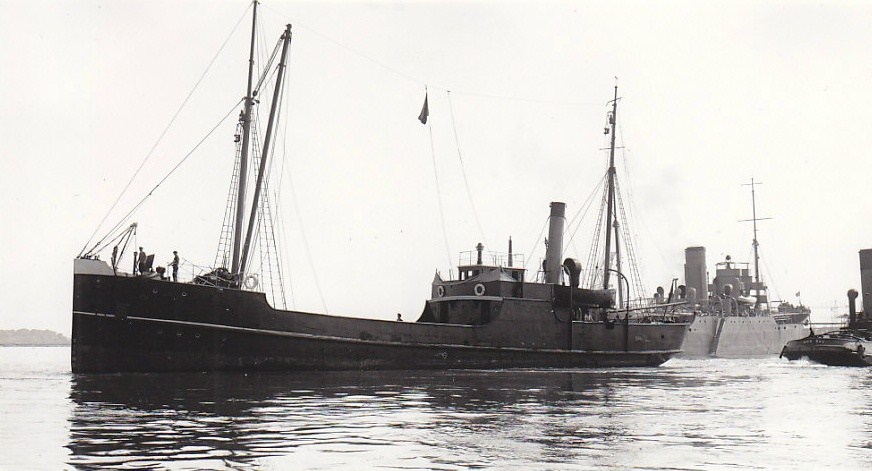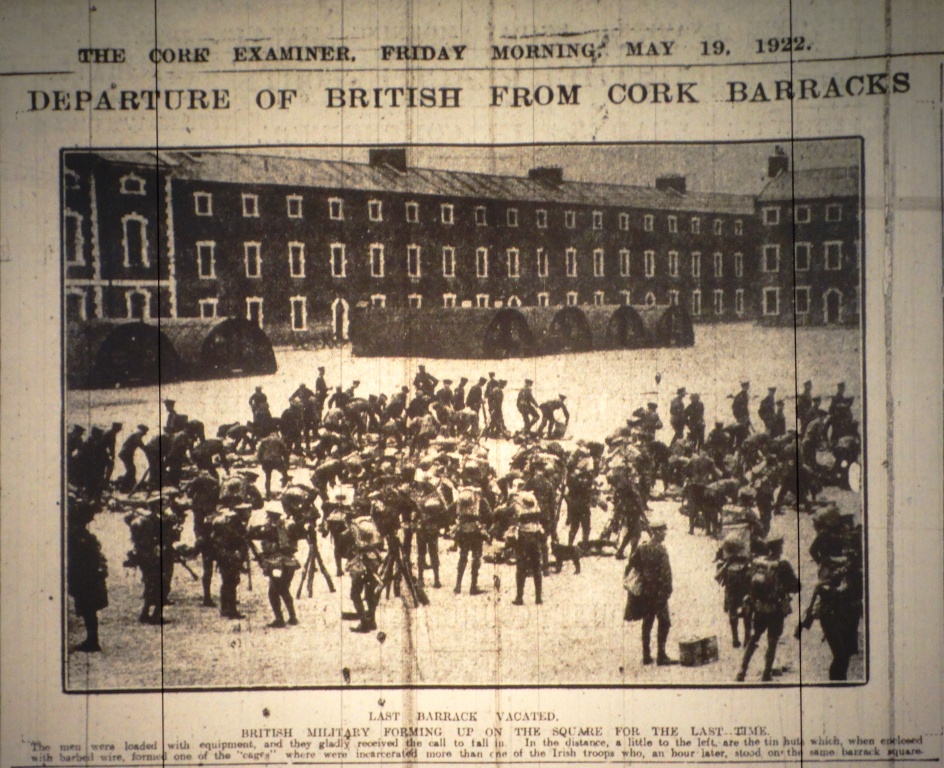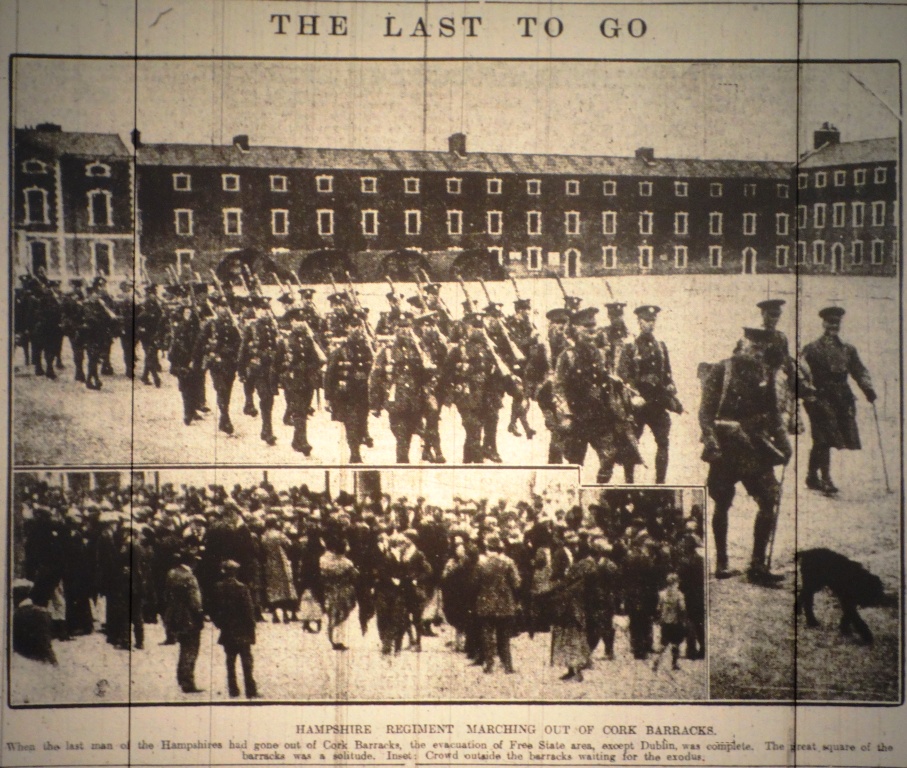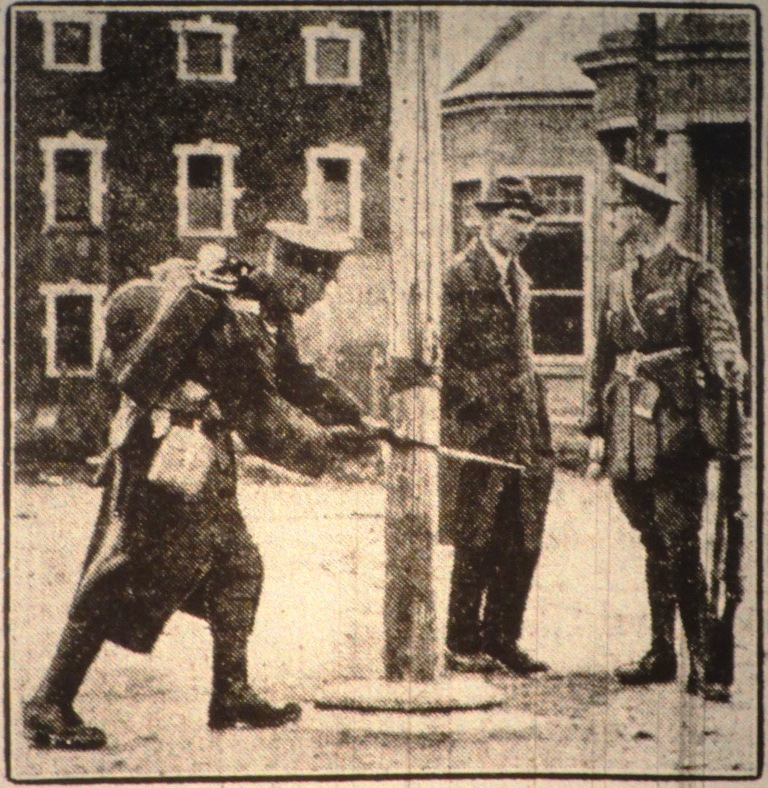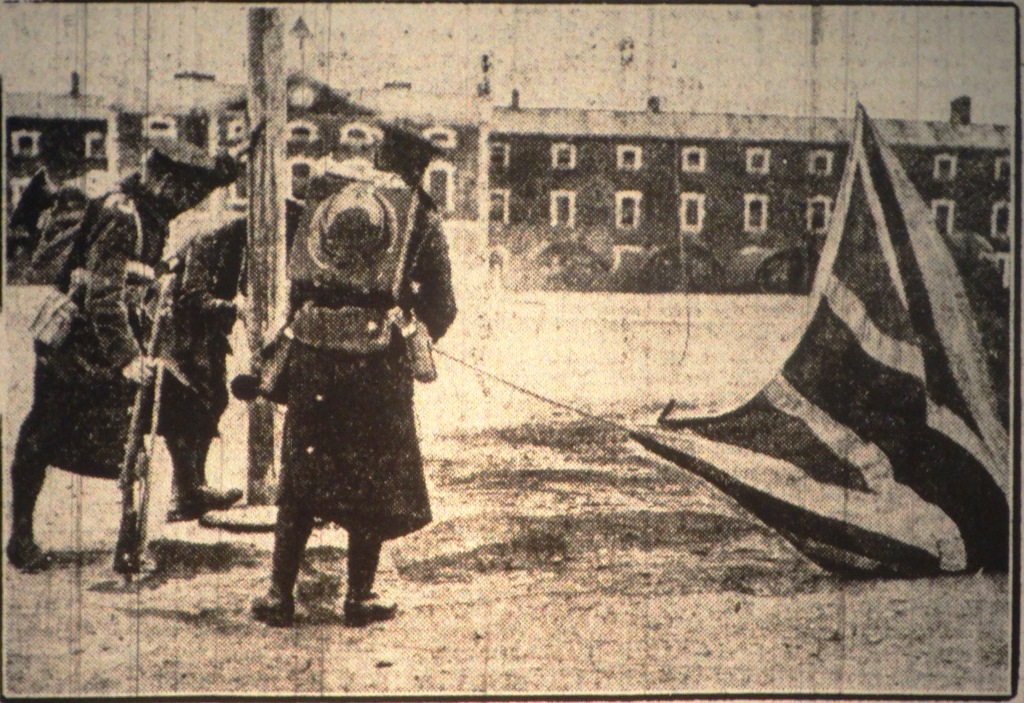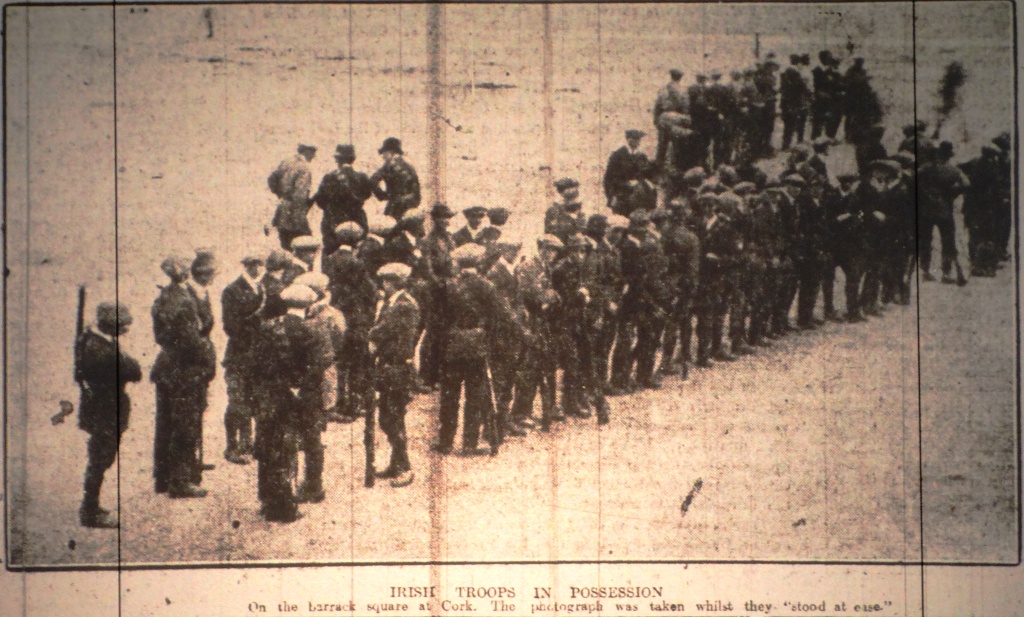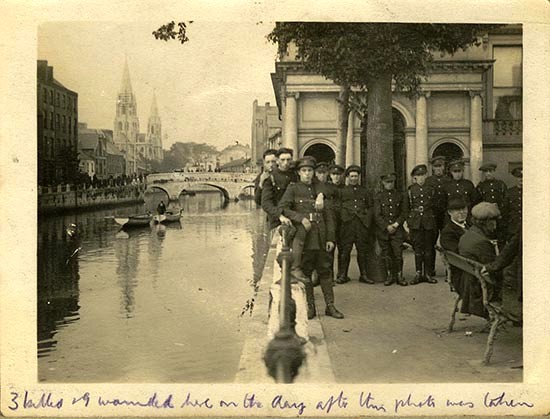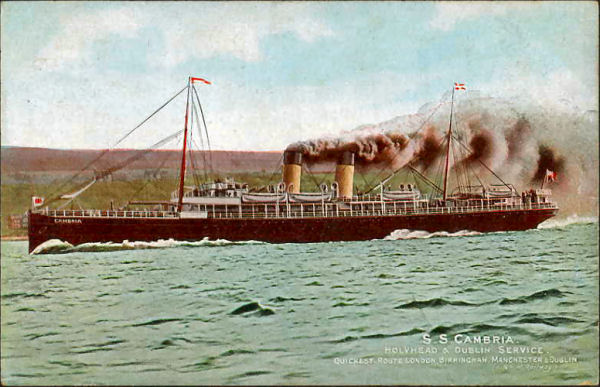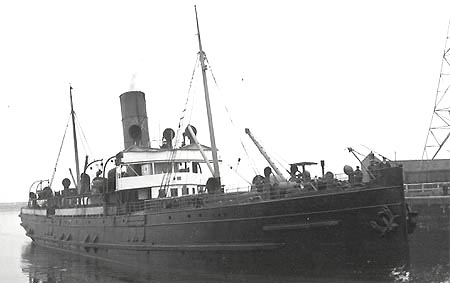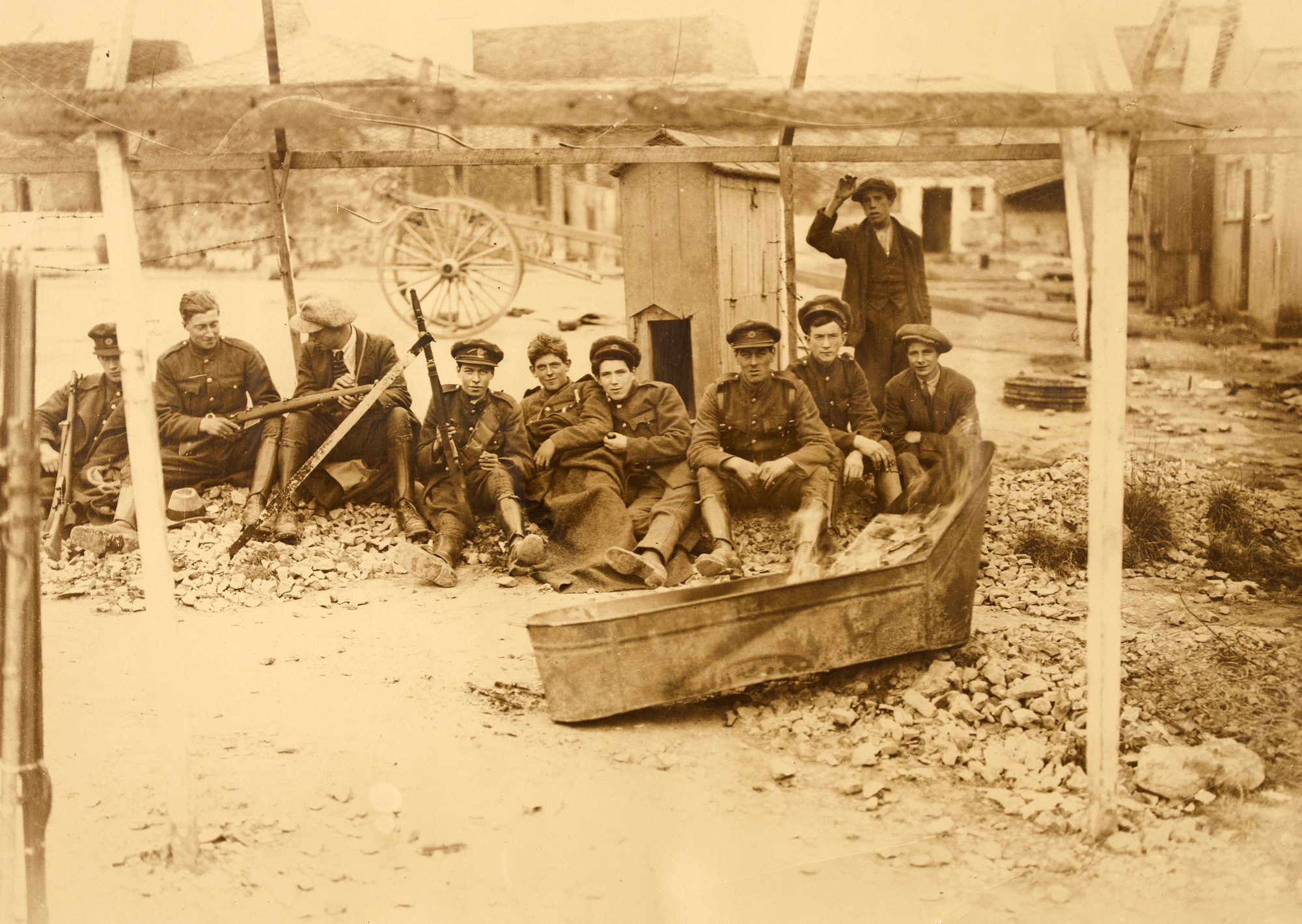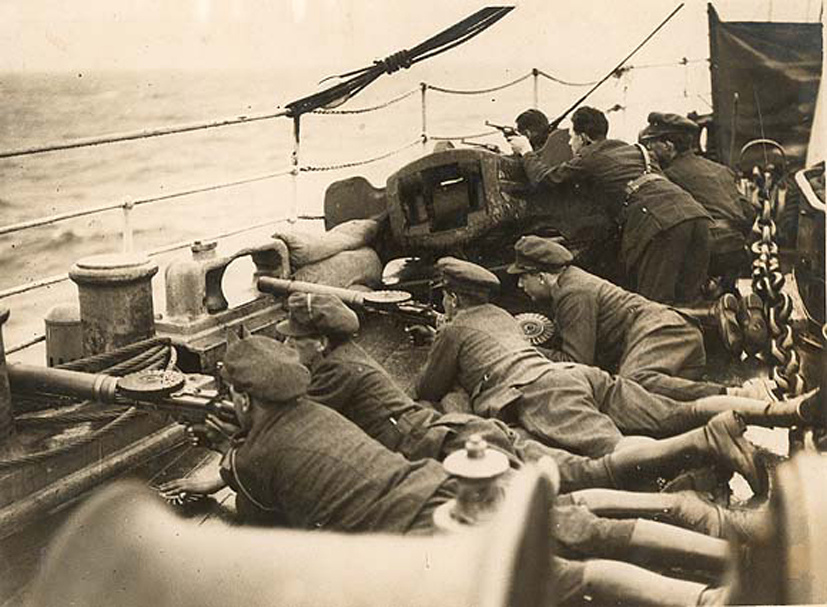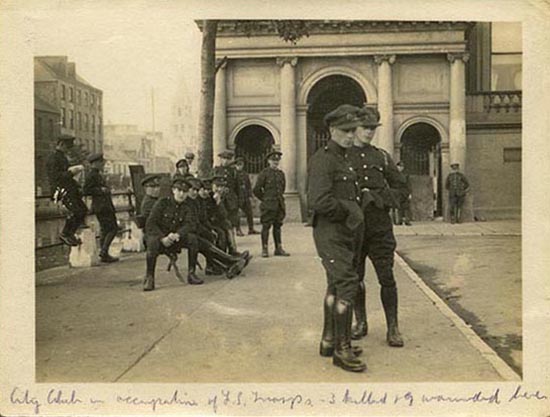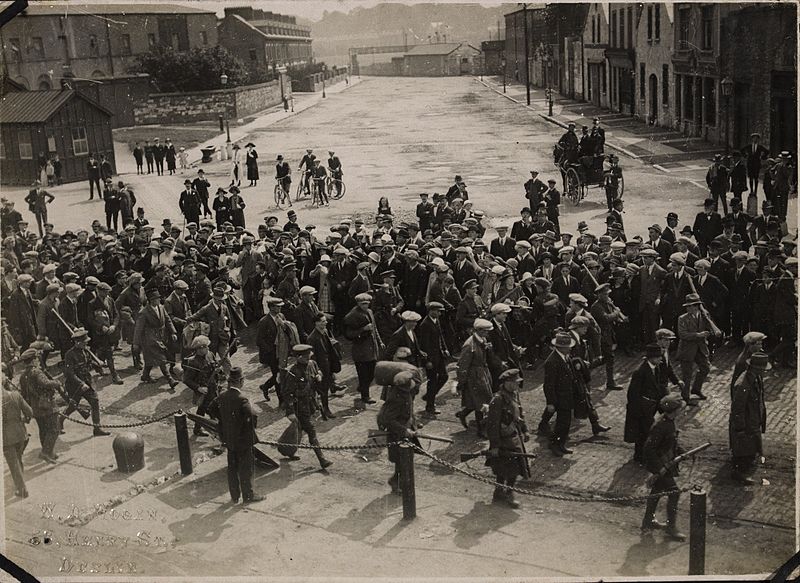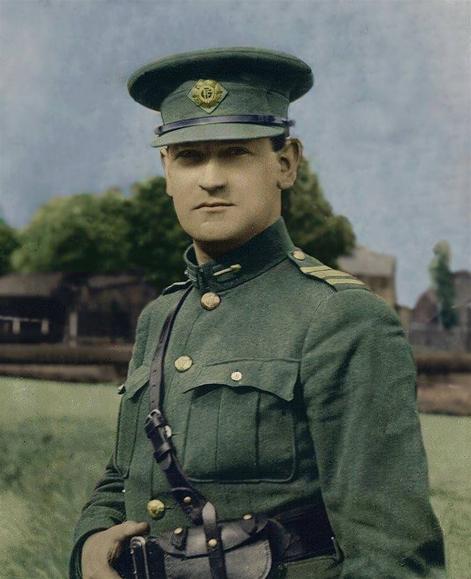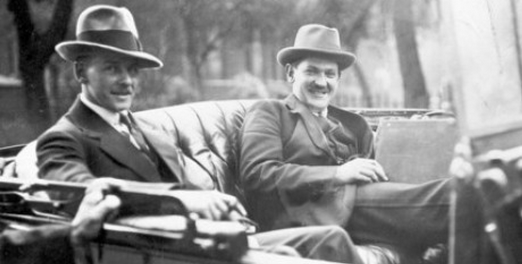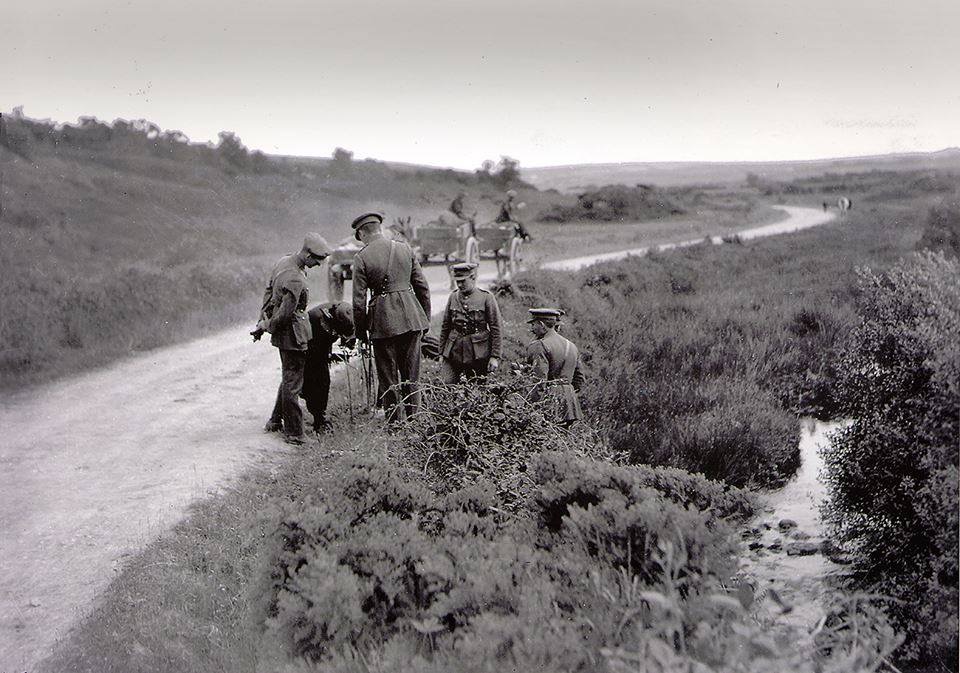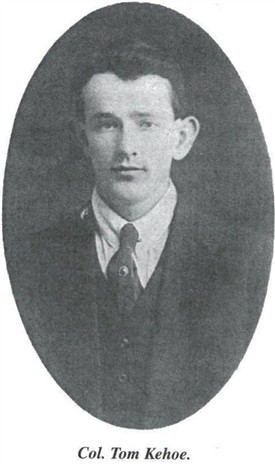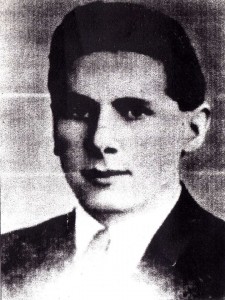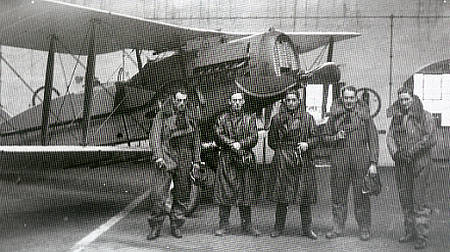-
De Valera Anti-Treaty Rally Cork
February 19th, 1922On Sunday 19 February 1922, an anti-treaty demonstration was held on Grand Parade in Cork City. The city streets were full of supporters as companies of Volunteers marched along and took up position in Grand Parade for the arrival of Mr De Valera, Cathal Brugha, Countess Markievicz and Mr Sean MacSwiney. Two large platforms were erected for the speakers on Grand Parade and all traffic within the city was halted.
-Countess Markievicz
The Lord Mayor, Councillor O’Callaghan. T.D. addressed the meeting in Irish and called out the meeting resolutions against the treaty. He then called on Mr De Valera to speak. As Mr De Valera took to the platform the crowd cheered and De Valera shouted “Up the Republic”. De Valera read out the resolutions:
-- “That we the citizens of the Southern Capital, in mass meeting assembled, at this fateful hour. When the common weal is in danger when the rights of our nation are being surrendered and the aspirations of our people misrepresented, hereby confirm and proclaim that the Irish nation is one indivisible: that all State authority in Ireland is derived solely from the people of Ireland: that the British Crown is an alien Crown: that Ireland is not part of the British Empire, and that the Republic of Ireland alone expresses the free will of the Irish people.”
“That for this reason we renew our allegiance to the Republic and pledge ourselves to maintain and uphold it by every means in our power.”
“That we call upon our fellow countrymen and fellow country women to do likewise, and appeal to the members of our race and to Ireland’s friends and the friends of liberty throughout the world to lend us their support.”
“That the ‘Articles of Agreement' signed in London do not represent the true desires of the Irish people: that as an agreement obtained under duress we repudiate it and it is not within the competency of Dáil Eireann to give it legal sanction: that the British Parliament has no power to make any laws binding Ireland, and that therefore this pretended Treaty between Ireland and Britain is null and void and without binding force on Ireland unless the Irish people of their own free will disestablish the Republic.”
“That to force upon the Irish people an election which would involve the recognition and acceptance of partition and the possible disestablishment of the Republic before Dáil Eireann has considered and given its express sanction to such an election is unconstitutional and illegal.”
“That any attempt by Irishmen to disestablish the Republic to lead the Irish people away from their strong fighting position before the British Forces have evacuated the Country, or to commit the Irish people irrevocably to the acceptance in advance of the proposed new State before its Constitution is definitely before them, or whilst it is possible for the British Parliament to alter or reject it, is an obvious betrayal of Ireland's interests and is not to be tolerated.”
“Resolved also that the soldiers and prisoners, particularly the wounded, and their dependants. The men and women who have sacrificed and suffered most during the war, should be the object of the nation’s first care. That we appeal to all our people to give them first preference in employment and otherwise to assist them by every means in their power, and that in all schemes of reconstruction and reparation, their claims shall receive prior instigation and satisfaction.” --
-Grand Parade
After de Valera had finished his speech, Miss MacSwiney, Mr Cathal Brugha, Mr Liam Mellows and Countess Markievicz addressed the crowd. The resolutions were then put to the meeting from the two platforms, and in each instance were carried unanimously and with acclamation. At the end of the meeting one of the Bands played “The Soldiers Song”, after which the crowd dispersed.
Cork Examiner, 20 February 1922, page 5
Cork Examiner, 20 February 1922, page 3
Southern Star, 25 February 1922, page 2
-
Michael Collins in Cork
March 12th, 1922On Sunday 12 March 1922, Michael Collins and prominent supporters took part in a Pro-Treaty Rally in Cork City. It was one of the largest rallies Cork city had witnessed with 50,000 people showing their support for the Treaty on Grand Parade.
Mr Michael Collins arrived on Saturday night with prominent supporters of the Treaty. They were welcomed by the people of Cork with bands, tar barrels and torches. The crowd marched alongside Mr Michael Collins and his compatriots to Turner’s Hotel, where they were staying for the night before the rally.
-Grand Parade Rally
On Sunday, the crowd numbered 50,000 and the city was filled with supporters. A platform was erected by the National Monument on Grand Parade for the speakers. Mr Barry M. Egan presided, and prominent members of the public and clergy took their places on the platform in support of Michael Collins and the Treaty. First to speak was Liam De Roiste, T.D who addressed the people in Irish and then in English. Following Liam De Roiste was Michael Collins. When Collins was introduced the crowd cheered, hats and handkerchiefs were waved, drums were played, and the crowd cheered for several minutes.
-Grand Parade Rally Front View
Mr Michael Collins began his speech by saying:
“First of all, I want to thank you, citizens of Cork, for the way you received me. Secondly, I want to thank two small children from a poor district of Cork City for the present of flowers they made me. These bouquets were sent from the lower part of Grattan Street, and I am glad it was one of the poorest parts of Cork city that sent these flowers”, at this point a voice was heard saying “The hearts of the people are with you”. Mr Collins continued his speech with “because it is the poor people who have always been with us. It is better to have the poor with us (cheering). I come here to speak to you today. I, as one of the “incompetent amateurs” who has seized the helm of the ship of the Irish State, and has driven it on to the rocks. The captain himself was here addressing you two or three weeks ago (laughter)”, refereeing to the visit of De Valera,” and he told you he went to America and asked them to recognise the Republic that was set up in Ireland by the free will of the Irish people, but little did he dream that the day would ever come when he would have TO COME TO THE IRISH PEOPLE THEMSELVES!, asking them to affirm that Republic that itself had set up. And while the captain was away from his ship (cheers) that time in America the weather was very stormy. There was a regular hurricane blowing you in Cork will remember”.
Cork Examiner, 13 March 1922, page 5
Freeman's Journal, 13 March 1922, page 5
Freeman's Journal, 13 March 1922, page 3
-
The Capture of the Upnor
March 29th, 1922On Wednesday 29 March 1922, The British Naval ship, Upnor, was intercepted and boarded by the IRA who raided its cargo of arms and ammunition. There seems to be a little confusion on the dates of the capture. Some members of the IRA involved in the capture state that it all began on the 29 March, but another IRA member, Leo Buckley (WS: 1714), said it was the 3 April.
According to Daniel O’Donovan (WS: 1430) and Michael J. Burke (WS: 1424) the following is a breakdown of capturing the Upnor according to their witness statements on The Bureau of Military History.
Five weeks before the capture of the Naval Ship “Upnor, a member of C� Company, 1st Battalion, Cork No. 1 Brigade, named De. Courcy, who was employed in Haulbowline, was introduced to Daniel O’Donovan by Peter O’Donovan. De Courcy claimed it was possible to raid arms and ammunition from a ship that was docked and being loaded at the wharf in Haulbowline, due to the lack of security. At a second meeting, De Courcy was asked to get a copy of the ship's manifest as well as the report and he produced both to Brigade O/C Sean Hegarty. After a thorough examination of the report and manifest, Sean Hegarty, made the decision that the ship would be followed to sea, seized and taken to some port round the coast. Daniel O’Donovan was placed in charge of examining the coastline and selecting a suitable port in which to take the ship, while Michael J. Burke was put in touch with De Courcy for the latest available information so that Brigade Headquarters were up-to-date on any changes that may affect the plan.
The ship they were going to use was to be one of two tug boats already berthed at the Deepwater Quay in Cobh.
On the morning of the 29 March 1922, information was received that the Upnor was to set sail at 2.00 pm that day. Dan O’Donovan and Mick Murphy picked up Captain Jeremiah Collins and headed to Cobh at 11.30 am to meet the rest of the men. The men were armed with a Lewis machine gun, one Thompson submachine gun and each man carried two revolvers.
A tug called the “Warrior”was commandeered, its captain arrested and the crew placed under armed guard.
Once out of the harbour the tug took a course south-south-east, as this was the direction to Plymouth, the destination of the Upnor. The master mariner, Collins, new that the tug was doing nine knots and that the Upnor was at six knots, while calculating distance and time he concluded that the Upnor would change course to pick up fresh water and if he changed course now they would intercept them at 6:30pm, which they did.
As they approached the Upnor they raised the harbour masters flag and had one of the Cobh seamen wave a brown envelop while shouting “message from the admiralty” through a megaphone. The Upnor sent over a small boat to collect the envelope but as the sailors came close to the tug they were taken captive and placed in the cabin with the crew from the Warrior. The I.R.A then used the same row boat to go over to the Upnor as they were being covered by the Lewis machine gun. Once aboard them over powered the crew and locked them away. The engine crew of the Warrior were then released and ordered to the Upnor in order to get it running. Once the engines were running the Upnor followed the Warrior to Ballycotton.
When they arrived at Ballycotton they were greeted by Michael Leahy in a small boat with two local pilots for the ships. It was now 1:30am as the came close to shore and were greeted buy 500 men, seventy six Lorries and five steam wagons. They emptied one thousand rifles, one thousand Webley revolvers (.45 calibre), one thousand Webley & Scott (.55 calibre) pistols, one hundred thousand rounds of .303 calibre ammunition, some thousand rounds of revolver ammunition, a large stock of hand grenades, fifty Lewis machine guns, six Maxim machine guns and a large number of mines. Each Lorry was loaded with a different portion of the arms and ammunition and the sent to different brigade areas. They finished unloading at 10am on Thursday morning, the 30th of March.
In order to keep the offloading of materials a secret the I.R.A took over the Ballycotton telephone exchange and closed off the roads that their own transports were not using with trenches.
>Cork Examiner, 3 April 1922, page 5
-Bureau of Military History
The above information has been sourced from The Bureau of Military History Daniel O'Donovan(WS: 1480) Volunteer Witness Statements.
-Bureau of Military History
The above information has been sourced from The Bureau of Military History Michael J BurkeWS: 1424) Volunteer Witness Statements.
-Bureau of Military History
The above information has been sourced from The Bureau of Military History Leo Buckley(WS: 1714) Volunteer Witness Statements.
-
The Dunmanway Killings
April 29th, 1922Between the 26th and 29th of April, 1922, there were thirteen violent killings in West Cork which later became known as “The Dunmanway Massacre�. They shocked the nation. Some believed they were retaliation killings because of the death of I.R.A Commandant, Michael O’Neill, who was shot and killed by a local loyalist named Herbert Woods, as he was entering the house of the Hornibrook family with the purpose of commandeering their family car. This action later lead to both the Hornibrook men of the house and Herbert Woods to be arrested by the I.R.A and then executed. This action inflamed tensions in the area which resulted in ten further deaths. Each person killed was called from their homes, and as they answered they were shot dead at their front doors. The armed men responsible for the killings were never found or identified even after spending three nights on a killing spree in Dunmanway, Ballineen and the Murragh area. Two of the victims were only 16 years of age and the eldest was, Mr Francis Fitzmaurice, aged 73.
-Commandant Michael O'Neill
The Following is a list of the dead and their locations:
Thomas Hornibrook—April 1922—Ballygroman—Dunmanway—Killed April 26 1922 Sam Hornibrook—April 1922—Ballygroman—Dunmanway— Killed April 26 1922 Herbert Woods—April 1922—Ballygroman—Dunmanway— Killed April 26 1922 David Gray—April 1922—Dunmanway—Dunmanway— Killed 26 April 1922 Francis Fitzmaurice—April 1922—Dunmanway—Dunmanway— Killed 26 April 1922 James Buttimer—April 1922—Dunmanway—Dunmanway— Killed 26 April 1922 Gerald McKinley—April 1922—Ballineen—Dunmanway— Killed 27 April 1922 Robert Nagle—April 1922—Clonakilty—Dunmanway— Killed 27 April 1922 Robert Howe—April 1922—Kinneagh—Dunmanway— Killed 27 April 1922 John Chinnery—April 1922—Kinneagh—Dunmanway— Killed 27 April 1922 John Buttimer—April 1922—Manch—Dunmanway— Killed 27 April 1922 Jim Greenfield—April 1922—Manch—Dunmanway— Killed 27 April 1922 John Bradfield—April 1922 –Bandon—Dunmanway— Killed 29 April 1922
-Herbert Woods
Tensions at this time were very high in Ireland due to an uneasy Truce between the Republicans and the British forces while the Treaty was being considered. This was also a period marking the end of the War for Independence and then the beginning of the Civil War. At the beginning the killings were condemned by both side and seen as a sectarian massacre. Just a month before, twelve Irish Catholics in Belfast were killed by the R.I.C.
-The Examiner Dáil Condemnation
Eamon De Valera who was the leader of the Anti-Treaty Republicans condemned the killings two days later in Mullingar. Arthur Griffith who was the President of the Provisional Irish Government also condemned the killing by saying:
“Events, such as the terrible murders at Dunmanway …, require the exercise of the utmost strength and authority of Dáil Éireann. Dáil Éireann, so far as its powers extend, will uphold, to the fullest extent, the protection of life and property of all classes and sections of the community. It does not know and cannot know, as a National Government, any distinction of class or creed. In its name, I express the horror of the Irish nation at the Dunmanway murders.”
The I.R.A leadership responded to the massacre by posting armed guards on the homes of known Protestant families in order to prevent any further killings that would lead to an escalation of deaths. A notice was issued by Tom Hale, Brigade Commander, “to give all citizens in this area, irrespective of creed or class, every protection within my power”.
Cork Examiner, 1 May 1922, pages 5 - 6
Freeman's Journal, 29 April 1922, page 3
-
Victoria Barracks Hand Over
May 18th, 1922On Thursday night 18 May 1922, British Forces handed over Victoria Barracks (Collins Barracks) to the Irish Republican Army. Then handover had been delayed because the transport ship that was to collect the British forces had sailed into a warship as it made its way into Cork harbour. The damaged ship had to go for extensive repair and a replacement ship sent instead.
-British Troops Leaving
The last of the British Forces finally left the barracks at 7.00 pm, and departed Ireland at 8.00 pm from Custom House Quay on the ship, SS. Classic. There was little ceremony to mark the handing over of the Barracks. It all began with the arrival of Captain Hugh MacNeill, from Beggar’s Bush, arriving at the barracks at 5pm, accompanied by another Officer representing the Provisional Government. They were greeted by the British Officer, Captain J. G. Magahy, Divisional Officer R.E., who escorted them both through the buildings of the Barracks. At the time of the Irish representative's tour, there were 400 soldiers of the Hampshire, North Staffordshire, and York Regiments formed up at attention in the main square waiting on orders to leave the Barracks. They stood at attention for over two hours, in full kit and carrying rifle’s before they were given the ordered to leave the Barracks. Before the British Troops left they cut down the flag post in the main square and retrieved their Union Jack Flag.
-Cutting Down Of Flag Post
Before the British Troops left the Barracks, there was an advanced party of Irish troops who had entered the Barracks through the rear gate. The Irish Troops remained at the rear gate until the British Military had handed over the keys of the main gate to I.R.A Captain MacNeill. It was not until 8pm that a force of 200 Irish Soldiers of the 1st Cork Brigade, armed with rifles, and headed by a band of pipers, entered the Barracks by the front gate and formally took possession of the Barracks. The advanced party from earlier took up position in the guard room right after the British Forces had left.
-Taking of The British Flag
-Irish Troops Take Over
Cork Examiner, 17 May 1922, page 5
Freeman's Journal, 19 May 1922, page 5
-
The Battle for Cork
August 8th, 1922Between 24 July 1922 and 10 August 1922 the Irish Free State carried out a series of seaborne landings in a strategic offensive to take the South and West of Ireland from the anti-Treaty Republicans who held Munster and Connaught. The plan to use seaborne landings was first proposed by Emmet Dalton and then adopted by Michael Collins. The plan was to avoid the majority of the Anti-Treaty forces who had most of their troops covering the roads and countryside, by inserting the Pro-Treaty troops close to the mainland towns via the sea to catch them off guard. To do this, the Irish Free State commandeered several civilian ships to carry troops. These ships were called the Arvonia and the SS Lady Wicklow. The Irish Free State also had the use of the Helga and the Alexandra for carrying troops and were escorted by the British Navy.
-The Arvonia
-The Lady Wicklow
The Republican forces had previously pushed the National Army out of most of the region and had held a defensive line across Munster, which was anchored by Limerick city and Waterford City. The Republican forces were split into a number of brigades and battalion columns. Each of these comprised of about twenty to fifty men. Unfortunately for the Republican fighting force, the National Army was growing in size and also had the use of armoured vehicles, artillery, the beginnings of a Navy and soldiers who were far better armed and supplied.
-National Army At Limerick
The National Army took Limerick on the 21 July and Waterford city on the same day, which pushed the Republican forces back into Cork. Within a few weeks the National Army took Carrick-on-Suir and Clonmel with the most intense fighting occurring during a two week battle for Kilmallock, which spilled into the nearby towns of Bruff and Bruree.
-National Army At Passage West
The largest of the sea landings took place on the 8 August, when Emmet Dalton initiated his plan of having three simultaneous landings of troops at Youghal, Union Hall and Passage West in County Cork. Even though the Republican forces did expect troops coming in from the sea and they did sabotage some dock facilities, it was not enough. The National Army troops came ashore in large numbers and pushed aside the light Republican forces stationed at Youghal and Union Hall. Cork City was far more difficult to secure from the Republican Forces as they had larger numbers stationed within the city and they were far more effective at a war of attrition compared to the less experienced Soldiers of the new National Army.
-National Army Grand Parade
After a three day intensive battle for Douglas, on the outskirts of Cork city, the National Army once again was able to push the Republican Forces back because of their armoured cars and Artillery. As the National Army drew closer to the City of Cork the Republican Forces pulled out in small sections while others kept the pressure on. This allowed many of the Republican Forces to fall back to the Mountainous region of Ballyvourney in West Macroom. Here it would be almost impossible for the National Army to deploy its Artillery and Armoured cars in a short period of time.
-Republican Prisoners
As Emmet Dalton's forces pushed inland across County Cork and Eoin O’Duffy’s forces began their move south after taking Kilmallock, Liam Lynch ordered his Republican forces to scatter and to engage the enemy in guerrilla style tactics as they no longer had the numbers and equipment to fight the National Army in a conventional way. Even after the defeat of the Republican forces by the National Army on the 10th of August, 1922, the Republican forces still managed to escape with many hardened fighters on its side. Later this would prove devastating to the National Army as it made policing Munster almost impossible.
Irish Independent, 10 August 1922, page 5
Irish Independent, 11 August 1922, pages 5 - 6
Irish Independent, 12 August 1922, pages 4 - 6
-
The Death of Michael Collins
August 22nd, 1922On Tuesday the 22 August 1922, Michael Collins was staying at the Army General Headquarters, a temporary set up at the Imperial Hotel, as part of an official visit to Cork and the surrounding areas. At around 6.00 am that morning Michael Collins left the hotel in his Leyland touring car, along with a military escort of one Crosslet Tender at the front and one armoured car at the rear. The convoy was set to visit Bandon, Clonakilty and Skibbereen by taking the Ballincollig, Coachford road to Macroom in order to deliver military supplies to Captain Conlon at the Macroom Barracks. The journey to Bandon was slow and dangerous because of the ongoing Civil war between the Pro-Treaty National Army and the Anti-Treaty Republican Forces.
The war was being fought with guerrilla tactics with bridges destroyed with explosives and many of the roads were blocked by felled trees. This meant the convoy had to detour the by-roads from Macroom through Toames and Kilmurry villages rejoining the Bandon road at Crookstown. On route to Bandon the convoy made an unscheduled stop in order to ask for directions to Bandon at public house called Longs Pub, located at Beal na mBlath. Unfortunately a number of Anti-Treaty Republicans were meeting close by at the farm house of Bill Murray, which overlooked the crossroads. A sentry on duty at Beal na mBlath Cross saw the convoy and was able to identify Michael Collins as it passed through. The sentry, Dinny Long, then informed the senior officers who were having a meeting in Murray’s farmhouse. Later that day the Commanding Officer of the Anti-Treaty Republicans, Liam Deasy, arrived at the farm accompanied by De Valera. Once they were informed about Michael Collins being part of the convoy they decided to put an ambush plan together on the assumption that the convoy would take the same route back.
-Collins and Dalton
Later that day about 7.00 pm, the convoy was on its way back to Macroom along the same route it had travelled that morning. Just outside Beal na mBlath they hit a wide corner on the road when they were hit by a volley of machine gun and rifle fire. Emmet Dalton ordered the driver to “Drive like hell!” but Michael Collins placed his hand on the drivers shoulder and ordered him to “stop. Jump out, we will fight them.” The convoy came to a halt and those inside the touring car jumped out and took cover on a small mud bank on the left side of the road. The armoured car backed up the road and opened fire in the direction on the ambushers. Michael Collins, Emmet Dalton and Joe Dolan opened fire on in the direction of the ambushers who, being on a raised area, gave them a distinct advantage.
After 20 minutes of continuous fire there was a moment of reduced fire, as if the ambushers were moving position or reducing fire to conserve ammunition. At the moment Michael Collins took to his feet behind the armoured car to get a better view of the enemies’ position. He used the armoured car as cover while he fired a number of shots back at the ambushers and scanned the area. He was then able to make out the ambushers position and called it out to his fellow officers, “There they are running up the road.” Michael Collins then began to move away from the armoured car and pursue the ambushers as he saw them run up the road. He took a prone position about 40 yards from the armoured car and fired at the enemy.
-The Big Fella
Emmet Dalton recalls how the officer in charge of the escort rushed back towards him and informed him that the ambushers had fled from the front and that they had removed the blockade by saying “They have retreated from in front of us and the obstacle is removed; where is the Big Fella?”. Emmet Dalton told the officer that Michael Collins was a few yards from them and firing at the retreating enemy when he hears Michael Collins cry out “Emmet, I am hit”. Emmet Dalton and the officer ran to Michael Collins’s position and found him motionless and still in a firing position grasping his rifle upon which his head was resting. They could see that he had been hit in the head on the lower side of the right ear and realised he was beyond help.
When Emmet Dalton realised that Michael Collins was mortally wounded he noticed that the enemy must have seen it too as they intensified their fire. Commandant O’Connell then knelt down to Michael Collins and spoke the words of the Act of Contrition into his ear. Emmet Dalton kept up covering fire as Commandant O’Connell pulled Michael Collins to cover behind the armoured car. Emmet Dalton attempted by apply a field dressing to his wound but Michael Collins passed away.
-Ambush Site Investigation 23rd
The ambushers then began to fully retreat and Emmet Dalton, Commandant O’Connell and John Smith carried the body of Michael Collins into the back of the armoured car. The convoy brough the body of Michael Collins to Shanakiel Hospital.
Cork Examiner, 24 August 1922, pages 3 - 4
Cork Examiner, 25 August 1922, pages 3 and 5
Cork Examiner, 26 August 1922, page 5
-
The Attack on Macroom
September 2nd, 1922One of the largest attacks organised by the Irregular Troops (anti-Treaty Irish Republicans) took place in Macroom. It was reported by the National Army Command Headquarters that Macroom was assaulted by 200 Irregular Troops on Saturday the 2nd of September, 1922.
The report states that the 300 strong Irregular Troops were heavily armed with 10 Lewis machine guns, 2 armoured cars and 1 trench mortar. The attack took place at 5.00 am while the town was closed and the population asleep in their beds. This early time would have taken the National Army Troops by surprise and could have led to the victory of the Irregular Troops. The attack lasted until 1.30 pm before the Irregular Troops were pushed into retreating by the National Army. During the 8 hour battle of Macroom the National Army suffered four casualties, two being wounded and two killed in action. The Irregular Troops suffered far larger casualties and needed the aid of horse transport to remove the bodies of their fallen comrades.
It was about 2pm before the fighting completely halted.Cork Examiner, 4 September 1922, page 5
Freeman's Journal, 4 September 1922, page 5
Irish Independent, 4 September 1922, page 5
-
Death of Commandant Tom Kehoe
September 16th, 1922On the morning of Saturday the 16th, 1922, Commandant Tom Kehoe was part of a Free State convoy assigned to remove a mine that had been recently discovered a short distance from the Carrigaphooka Bridge, three miles west of Macroom. Three ex-members of Michael Collins’ Squad were involved in the incident and had been at Beal Na mBlath on the day of the ambush on Michael Collins and his convoy. Those three were Tom Kehoe, Jimmy Conroy and Johnny Wilson. Jim Slattery stated he was there at the time of Tom Kehoe’s death so it is possible he was also in the convoy.
The Examiner's correspondent from Macroom investigated the incident and gave a brief but detailed description of the event. It was reported that on the morning of the 16th of September a flying column from Macroom were in search of Irregular Troops equipment and hidden explosive traps in the areas of Carrigaphooka and Clondrohid. When the convoy was informed of a road side mine placed close to the bridge at Carrigaphooka they drove out in to disarm it at 7am. Commandant Tom Kehoe was in command of the convoy and ordered that the wires leading to the detonator be cut, as this was standard operating procedure in defusing a mine. Once the wires to the detonator were cut the earth around the mine was slowly cleared in order to remove it safely. Comdt O’Conlon and Col. Comdt Tom Kehoe (Thomas Keogh) approached the mine and gave the order to four of the men to go to the vehicle and to get a cross-cut saw to cut down a tree near the bridge. This was doneto create cover in case the mine exploded. As the men returned from the vehicle with the saw, the young recruit who cleared the dirt from the mine bent down and began to lift the mine from its position. It is thought that there was a second detonator in the mine, or that there was a hand grenade rigged to the bottom of the mine in case it was moved. As the Soldier raised the mine it exploded instantly killing Captain Dan O’Brien, Sgt William Murphy, Private Thomas Manning, Private John O’Riordan, Patrick O’Rourke and Ralph Conway. Col. Comdt Tom Kehoe was severely injured by the blast and later died of his wounds in hospital in Cork City.
- Cross-cut Saw
Comdt. O’Conlon stated that --“the mine was absolutely set to murder. It was a most diabolical arrangement, deliberately set to blow to atoms the man that touched it”--. Only a few weeks earlier they had responded to another mine and had removed it in the standard way of cutting the detonator. This mine at Carrigaphooka Bridge was very different as it was designed to be seen and then double rigged to explode if the main detonator was defused. Comdt. O’Conlon went on to say --“I had the mine removed because I could not possibly suspect my fellow countrymen of such treachery. It was a murderous act and I use the word murderous deliberately”--.
Cork Examiner, 18 September 1922, page 5
Irish Independent, 18 September 1922, page 5
-
Death of Commandant Sean Ó Donoghue
September 28th, 1922Sean Ó Donoghue, Cork No.1 Brigade I.R.A was appointed Commandant of the 1st Battalion in the beginning of 1921. Commandant Sean Ó Donoghue was involved in many engagements against the Black and Tans in the area of Cork city and was also at the signing of the Treaty, which he took a stand against in the Civil War and joined the Anti-Treaty Republican side.
There are two versions to how and why Commandant Sean Ó Donoghue was killed by Free State Troops on Thursday the 28th of September in 1922. One version is that Sean Ó Donoghue was in Cork city visiting the home of the Delaney brothers on Dublin Hill. As he was leaving the house a patrol of Free State Soldiers was lying in wait outside. Sean Ó Donoghue was arrested and taken prisoner along with other Republican Soldiers. It is said that during the time it took for the Free State Troops to bring the prisoners back to the Barracks they had first executed Sean Ó Donoghue close by Dublin Hill. Of course the Free State denied this and said that Sean Ó Donoghue was part of an ambush on the Free State Troops as they were taking the two cars back to the Barracks.
The local newspaper states that in the afternoon of the 28 September 1922, the National Forces consisting of one Officer and ten Soldiers were travelling in one Lancia car in the Carrignavar, WhiteChurch and White's Cross districts for some hours before they were ambushed. At White's Cross the National Forces were conducting searches for any equipment and personnel of the Anti-Treaty Republican Forces when they came across two motor cars known to belong to the Irregulars and seized them. The National Forces began to head back to Cork after 3.00 pm and when they reached Blackpool, some two miles beyond Dublin Hill, they were ambushed by twelve Irregular Troops. The National Troops halted their cars and engaged the Irregulars.
During the engagement Commandant Sean Ó Donoghue, the acting O.C, was apparently shot and killed. Two other Republican Troops were also seriously wounded in the engagement. The National troops secured four rifles, one short and one long Webley revolver, as well as about a hundred rounds of ammunition. It was reported that one of the rifles and one of the revolvers were loaded with Dum-Dum rounds, deadly ammunition designed to mushroom on impact and split into shrapnel causing horrific wounds.
It was reported that another ambush was initiated half a mile from the first ambush but the Irregulars dispersed very quickly and the convoy was able to make it back to Cork at 4:30pm without injury or damage.
Cork Examiner, 29 September 1922, page 5
-
First Aeroplane used In Civil War
December 4th, 1922On Sunday 4 December 1922, a column of Irregular Troops numbering around 60 men armed with rifles and machine guns ambushed two Lorries of National Troops. The National Troops were operating around the Drimoleauge and Dunmanway districts when they were ambushed by the Irregular Troops. At the first volley of shot directed at the National Troops, a Sergeant and native of Dublin was hit and killed. The National Troops took up position and returned fire but the Irregular Troops were too widespread and in superior cover for the National Army’s rifle to make effect.
During the engagement the National Troops requested reinforcements, and additional troops were sent from a variety of locations. For the first time during the Civil war the Air Force was also called in to reinforce the National Troops. Lieutenant Fitzmaurice and a pilot in a small single-seater scout aeroplane were the first of the reinforcements to arrive. The aeroplane was a single-engine biplane, a Martinsyde Type A mar II, which was bought to permit General Michael Collins to escape from London should the Treaty talks with Britain had failed. By June 1922 the Air Service HQ had been established at Baldonnel and 14 pilots flew a total of 13 aircraft.
The pilot targeted the Irregular Troops who were in the hills between Leap and Drimoleague. The pilot descended to a level of about 400 feet flying over the column of Irregular Troops, and then rapidly nose-dived towards them. The Irregular Troops were not equipped to deal with the Air Force and made their way for cover. As the Irregular Troops scrambled the pilot released several bombs from the Aircraft on their position with disastrous results. The Irregulars not injured or killed made for the nearby woods and the cover of the tree. As the pilot circled around he was unable to locate the Irregulars who had moved into the cover of the woods and so returned to base.
This was the first time the Air Force was called in to engage the enemy. The aircraft in the Air Force at the time were small and light which allowed them to fly close to the ground and evade any gun fire at a faster speed than larger craft. These airCraft proved essential for scouting and reporting on Irregular activities in a very short time and of course engaging the enemy who had no anti-aircraft weapons to defend against them.
Cork Examiner, 5 December 1922, page 5
Irish Independent, 5 December 1922, page 5
Freeman's Journal, 5 December 1922, page 5
